Last Updated 05/28/2024
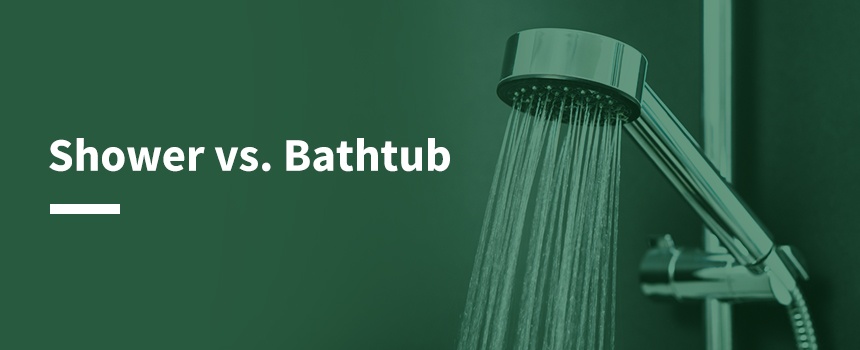
Are you thinking of exchanging your bathtub for a shower? Before you make your decision, you need to determine if it’s the best option for your home’s value and your lifestyle. See if your upgrade from just a bathtub to a shower or tub-shower combo will be worth the investment.
Understanding the Bath and Shower Difference
While these two are often related, baths and showers have key distinctions. The difference between a bath and a shower lies in how you clean your body and the water delivery. A bath refers to washing that involves a bathtub. On the other hand, a shower offers a continuous flow of water from an overhead spray.
Let’s discuss how each differs through a detailed coverage of their key components and benefits. This comparison guide will help you choose the most suitable solution for your home.
Key Parts of a Bath
- Basin: The biggest component of a bathtub is the basin, which is filled with water. It comes in different types, from alcoves and corner tubs to drop-ins and freestanding tubs.
- Tub spout: This is where the water runs through from the pipe connected to the faucet.
- Drain: The bathtub drain is the circular hole on the lowest section of the tub that eliminates the used water.
- Overflow: The overflow is the hole below the tub spout, directing excess water to its opening to avoid overflowing.
- Shower system: Some bathtubs have a shower that directs water up to the shower head.
Benefits
- Relaxes tired muscles and joints
- Helps increase blood flow
- Boosts skin health
- Enhances sleep quality
Main Components of a Shower
- Showerhead: Water flows out from the showerhead and onto your body. Showerheads vary in styles, such as fixed or handheld, top-mounted or wall-mounted and high-pressure or low-flow.
- Shower pan and strainer: The shower pan refers to the floor of the shower that collects water and directs it to the strainer.
- Shower valve and cartridge: Shower mixing valves regulate the water pressure and temperature. The cartridge is a supporting component that connects to the shower valve and the external handle.
- Water supply pipe: Modern showers offer both hot water and cold water supply pipes. The supply lines transport water to the shower valve.
Benefits
- Offers quick cleansing
- Relieves itchy skin
- Aids in relaxation
- Improves skin health
Should I Have a Bath or Shower in the Bathroom?
Most homes have more than one bathroom with a bath or shower in it. Instead of making one decision for every bathroom in your home, focus on just one room at a time. For smaller bathrooms, you may want to replace tubs with showers or leave one bathtub for guests with young children. The master bathroom, though, is where you will spend the most time and the area where home buyers will focus their greatest attention when looking over your home’s bathrooms.
1. Shower Resale Value
When considering resale value, you want to have your home appeal to as many buyers as possible. A shower is one feature that’s in-demand. Many people want at least one shower in their new home.
In a 2017 survey of homebuyers from the American Institute of Architects, large, walk-in showers increased in popularity from the previous year. In 2016, 54% wanted a walk-in shower in their homes. The next year, 64% of homebuyers wanted one. It’s not just walk-in showers that are popular. Among homebuyers, 23% wanted an upscale shower, 54% wanted a stall shower without a tub and 56% wanted a doorless shower. Having a shower in your home is definitely a benefit when selling.
Another aspect of showers that increases their benefit to homeowners is their application in universal design. The AIA survey found 59% of respondents wanted universal design, which allows for anyone to comfortably live in the home, regardless of age or mobility. Extra-large, curbless showers let people get in without tripping over a threshold.
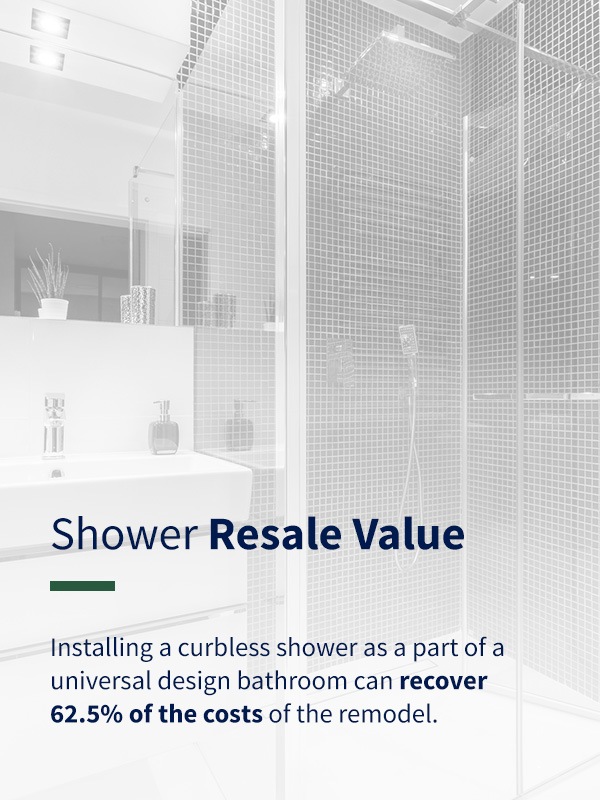
Installing a curbless shower as a part of a universal design bathroom can recover 62.5% of the costs of the remodel. Since it’s still a relatively new concept, 2019 was the first year of data was available for universal design. It’s likely that homes with universal design will increase in popularity as people grow older and have more need for accessible living spaces.
If you only have a tub in the master bathroom, you might want to consider adding a shower. A 2013 survey of home buyers found 80% of respondents demanded three features in a bathroom—a linen closet, an exhaust fan and a tub/shower combination in the master bathroom. Having both a tub and shower was so crucial that 30% of those surveyed would reject a home with only a shower in the master bathroom.
Your home’s size will also determine if removing all the tubs will affect home value. If you live in a studio apartment or a one-bedroom house, replacing the bathtub with a shower improves the space in the bathroom and can increase the home value by up to 10%. However, if you have more than one full bath in your home and take out all the tubs from them, your home can lose value.
If you do replace your tub with a shower, use the extra space to install an extra-large walk-in shower. The additional space in the shower feels more luxurious than a smaller stall, and you have the option of including a shower bench or luxurious showerheads.
2. Value of a Bathtub
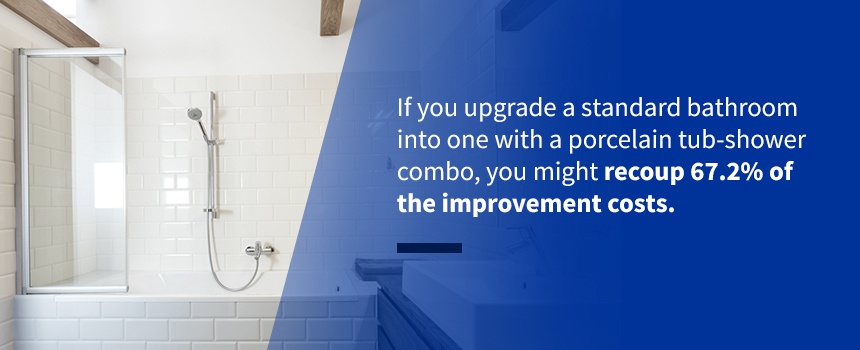
If you upgrade a standard bathroom into one with a porcelain tub-shower combo, you might recoup 67.2% of the improvement costs through increases in your home’s value. This remodeling project also includes a single lever to control the shower pressure and temperature and a ceramic tile surround around the tub-shower.
Even if you take out a tub in the master bathroom to install an extra-large shower, the prevailing advice from real estate agents around the country is to have at least one bathtub in your home. Following this advice for at least one room in your home means that families with small children might be more interested in buying your house. Many parents find it easier to bathe children in tubs rather than in the shower.
Some homes have large tubs with water jets, popular during the 1990s. While these tubs felt luxurious to lounge in and soothing to sore muscles, their immense size made cleaning difficult. Today, homeowners often choose to remove extra-large tubs and replace them with more space-conserving showers. You can retain a bathtub by switching out the large water-jet tub for a tub and shower combo, especially in a full bathroom.
Should you home only have one bathroom, instead of using a freestanding tub, which takes up a considerable amount of space, consider installing a shower-tub combo, so you get the benefits of having a shower and tub in your home. If you want more space in a guest bathroom that only has a tub, replace the fixture with a shower for space-savings, but keep the bathtub in your main bathroom for resale value.
Having a bathtub is still an essential feature in homes with multiple bathrooms, but you don’t have to have one a tub in every bathroom in your home. Converting some bathtubs to showers lets you keep at least one tub while giving you more space and convenience with showers in the other bathrooms.
Convenience
Because you most likely will stay in your home for some time before selling it, your lifestyle preferences should factor into your decision. Do you want the fastest cleaning option? Are you looking for luxury? Does energy efficiency matter to you? Several convenience factors come into play when you decide between a bathtub and a shower for your main bathroom.
1. Shower or Bath Time
Nothing beats a shower when you need to wash your body quickly. At the end of a long day, a hot shower can soothe sore muscles, too.
If you have the time to indulge in a soaking bath, few other luxuries can compare. Though you may not use a tub for your everyday grooming, you may still want to have one somewhere in your home for those evenings when you can relax in a soaking tub alone. Tubs with water jets are suitable for those with aching muscles or joints. Soaking in hot water helps to ease pain while relaxing the body in a tub can reduce stress.
2. A Little Luxury
If you want to add luxury to your master bathroom, have both a tub and shower. When choosing fixtures for a luxury bathroom, don’t skimp on features. For example, a freestanding tub provides an eye-catching centerpiece for any bath. But it doesn’t have to be the only luxury fixture in your master bathroom. You will want an equally elegant shower beside the tub.
Extra-large walk-in showers can give a spa-like experience with the addition of rain shower heads, water jets, and benches. A custom shower will let you decide all of the details, from the type of flooring and walls to the enclosure style and size.
3. Convenience for Specific Groups
If you or anyone in your household has mobility issues, a curbless walk-in shower with a bench makes getting in and out of the shower easier. For someone in a wheelchair or with a walker, a walk-in shower is a must-have. For areas with aging populations or places where older parents move in with their children, having a curbless walk-in shower becomes a benefit when you decide to sell your home.
While those with mobility issues can use a shower with greater ease, the same is not true of the very young. Parents of young children feel more secure in giving their little-ones’ baths during the years until the children can clean themselves in a shower. Depending on a family’s needs, it may need a tub for several years to tend to the needs of multiple growing children in the home. If you plan to sell your home, having a bathtub ensures that young families are among potential buyers for your home.
4. Water Use
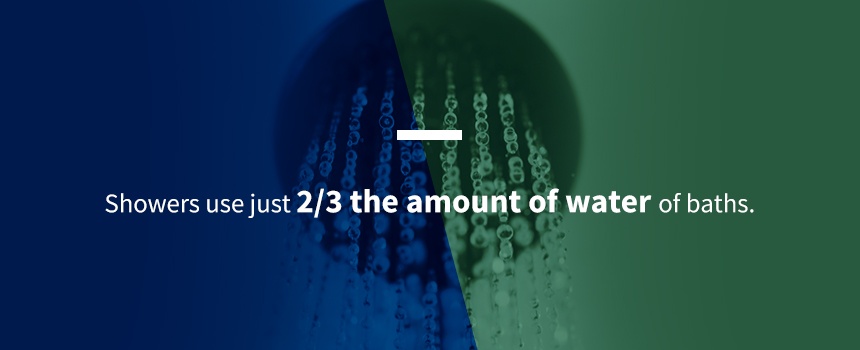
Showers use just two-thirds the amount of water of baths, 20 gallons vs. 30 gallons, respectively. If you have a deep soaker or whirlpool tub, the water use can increase to 80 to 100 gallons. Depending on your home’s water heater, you may need to upgrade the appliance to accommodate such significant water use.
The amount of water used during a shower can vary dramatically depending on the type of fixture you use in the shower and the length of your showers. A 10-minute shower using a low-flow showerhead uses 20 gallons of water. If you can reduce your shower time, you will use even less water. A tub, however, uses the same amount of water no matter how long you stay in it.
If you take hour-long showers until the hot water runs out, you may save water with a tub. A quick rinse under the shower, though, takes less time to prepare and uses much less water.
5. Cleaning the Fixture
Regardless of what you choose for your bathroom, you have to keep it clean. For some people, the amount of cleaning required compared to the time they spend in a tub does not provide a beneficial trade-off. Many people who chose to exchange their deep, water-jetted bathtubs from decades ago did so because the extra-deep fixtures proved challenging to clean.
If you choose a walk-in shower, cleaning becomes a more manageable task because you have only to clean the glass of the enclosure. Wiping off a glass shower door is more comfortable than bending over a deep tub to scrub it out.
Cost
There’s a big difference in the cost to install a shower compared to the cost to install a tub. If you want to convert an existing room into a new bathroom or add new fixtures in place, the costs for installing a shower average between $815 and $930. A tub will cost you anywhere from $1,100 to $1,800.
The exact costs will depend on where you live and the options you choose. A customized tub will most likely cost more than a prefabricated model. The same is true if you opt for a custom-built shower instead of a prefabricated model.
Although installing a tub or shower yourself might seem like a way to cut costs, it often ends up costing more in the long run. If you want to increase your home value, hire a professional to install your shower or tub. Having experts install any glass shower door or enclosure is especially vital because poorly set glass in these features can have problems. Professional installers know how to set the parts correctly to prevent such issues.
Shower-Tub Combo
Some homes, especially older ones, may not have a separate shower or space for one. If you would like to keep your tub but still want a shower, consider upgrading to a shower-tub combo. You can have a glass enclosure installed around these to prevent leaks and blown-in curtains when you choose to take a shower. The enclosure can also provide privacy for people taking a bath.
A shower-tub combo makes an excellent compromise if you have a single bathroom that can comfortably fit the unit. You can customize the tub-shower combo with surrounds, enclosures and doors of your choosing instead of choosing a basic fiberglass, one-piece unit.
Key Takeaways When Choosing Bath or Shower
Redesigning your bathroom is a significant move that needs to be planned thoroughly. Before you make a decision, assess the following:
- Hygiene: Do you prefer quick cleansing or deep cleaning?
- Lifestyle: What are your family’s personal preferences?
- Family size: Are you living primarily with kids, adults or older people?
- Space availability: Do you have enough space in your bathroom?
- Budget: What is your expected installation cost?
- Resale value: Are you planning to sell your home in the near future?
- Maintenance: Is maintenance a key factor in your decision?
Let Us Help With Your Bathroom Upgrades
When you want a new walk-in shower in your bathroom, you’ll likely need a glass shower enclosure or door. Contact us at Garrety Glass to get a free consultation to determine the best options for your bathroom. We can help you choose between a sliding glass door or one that swings open. We can also answer your questions about framed and frameless showers.
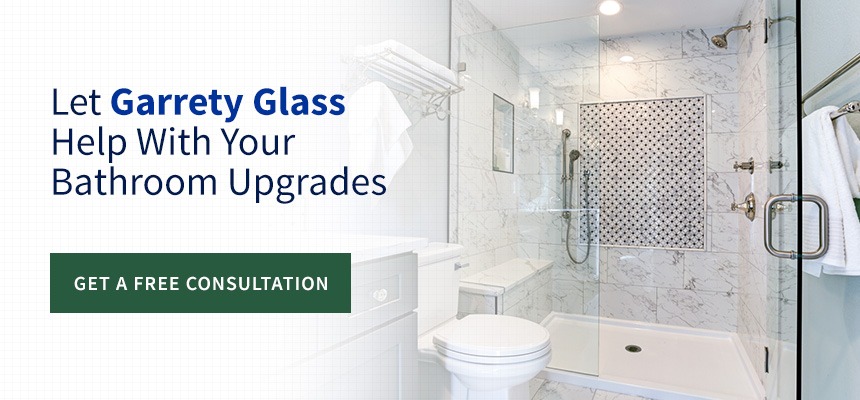
As experts in the glass business, we also do the installation with our employees, not independent contractors. You can feel safe letting our professional team into your home to renovate your bathroom with a beautiful new shower. With quality shower products and great prices, you cannot go wrong in choosing Garrety Glass for your shower upgrade.